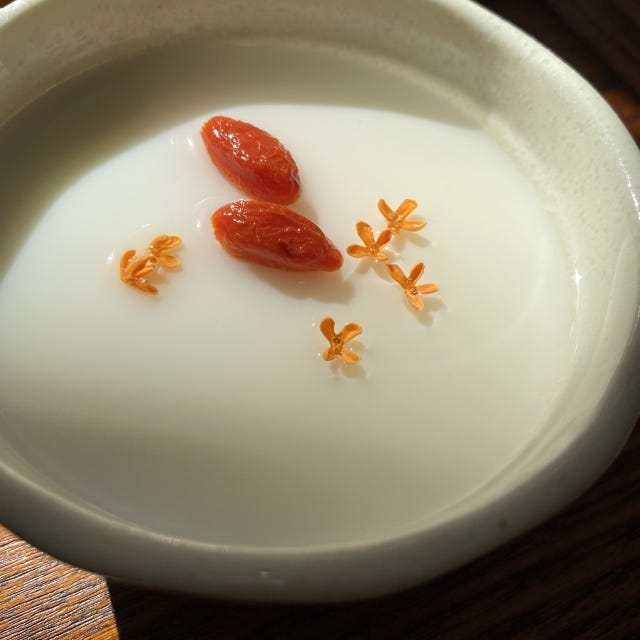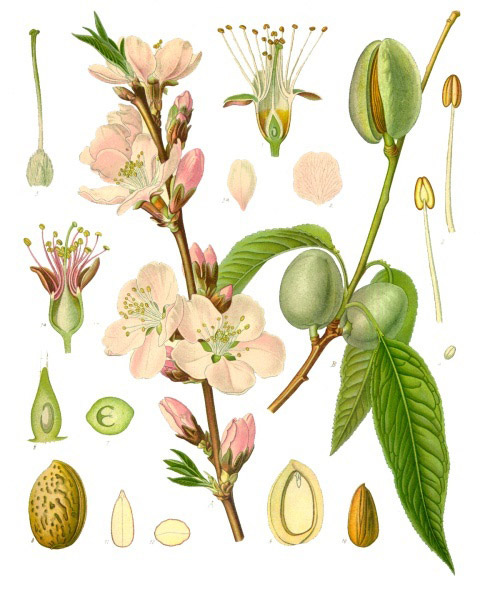One of the traditional Taiwanese dessert we have been serving at our Ja Ban Bae tasting menu is Almond tofu (杏仁豆腐) with almond tea (杏仁茶). You will see this popular dessert all across from Southeast Asia all the way out to Hawaii.
But did you know that it is not made with almond, but with apricot kernel?
When I first found out, I thought I had been lied to all these years. I remember thinking how almond milk in the states tastes nothing like what I had growing up. The stuff back home had that distinctive floral aroma. Have we been using some artificial extract or filler ingredients back home? Then I learn that it was actually a language translation issue, and this dish had always been made with apricot kernel!
Almond is one of the earliest domesticated fruit trees, with archeological records dating back to 2000BC in Jordan1. When it finally made its way to China by way of silk road, Chinese people didn't come up with a new character for it. There are some writings that refer almond as 扁桃仁 (flat peach kernel), but most people simply refer to it as 杏仁, sharing the same name as apricot kernel.
I've been researching to see how exactly the english word almond got conflated with apricot kernel. One Taiwanese website loosely mentions that the US importation of almond to the East during 1970s was the start of the naming confusion, but nothing definitive turned up. While more sleuthing is needed to get behind the almond naming mystery, let's take a closer look at our star of the dish - apricot kernel.
During the Three Kingdoms Period (220-280 AD), there was a physician by the name of 董奉 (Dong Feng). One legend says that he refused monetary payment from his patients, but asked them to plant apricot trees around his home instead - one for minor ailment; five for major illness.
Over time, the apricot trees grew into a forest, and the word 杏林 (Xing Lin - apricot forest) became a honorary term to describe where medical professionals worked. Today, you can still see many hospitals with the name 杏林 across Chinese speaking territories. This is similar to how in the US, one can find many hospitals named Cedar Sinai or Mount Sinai, in reverence to the Jewish heritage.
In Traditional Chinese Medicine, apricot kernel is an herb that can relieve coughing and wheezing. It's also high in fiber, antioxidants, essential vitamins, and protein. Its consumption has been linked to proper functioning of platelets in the human body and promoting cardiovascular health.2 However, despite its health benefit, apricot kernels actually pose a risk of cyanide poisoning if eaten raw.
But don't worry - it seems that our ancestors have figured out how to remove the toxin while enjoying its unique flavor long ago. Below is an almond tea recipe from 隨園食單, a venerable culinary manual written in 1792 by 袁枚 (Yuan Mei), an equally legendary gastronome:
捶杏仁作浆,抆去渣,拌米粉,加糖熬之
Mash apricot kernel into pulp. Filter out the sediment. Mix with rice flour, add sugar, then slowly cook over fire.
To make "almond tofu", one would simply add a coagulant like agar-agar to form a jelly like texture. Nowadays, you can find almond tea and almond tofu in popular international boba tea chains like Yi-Fang. Just remember that when you see almonds on the menu, they are really apricot kernels!
If you still find this almond naming mishap hard to believe, here's the kicker. Do you know that Amaretto, the popular almond flavored liqueur, is also traditionally made from apricot kernel?
Mansoor Ali Akhone, Aarti Bains, Mansuri M. Tosif, Prince Chawla, Melinda Fogarasi, and Szabolcs Fogarasi (2022), Apricot Kernel: Bioactivity, Characterization, Applications, and Health Attributes






